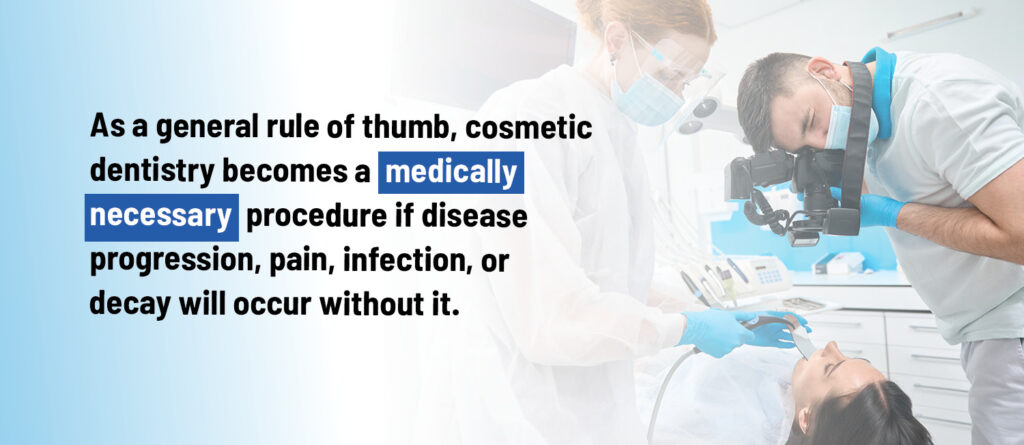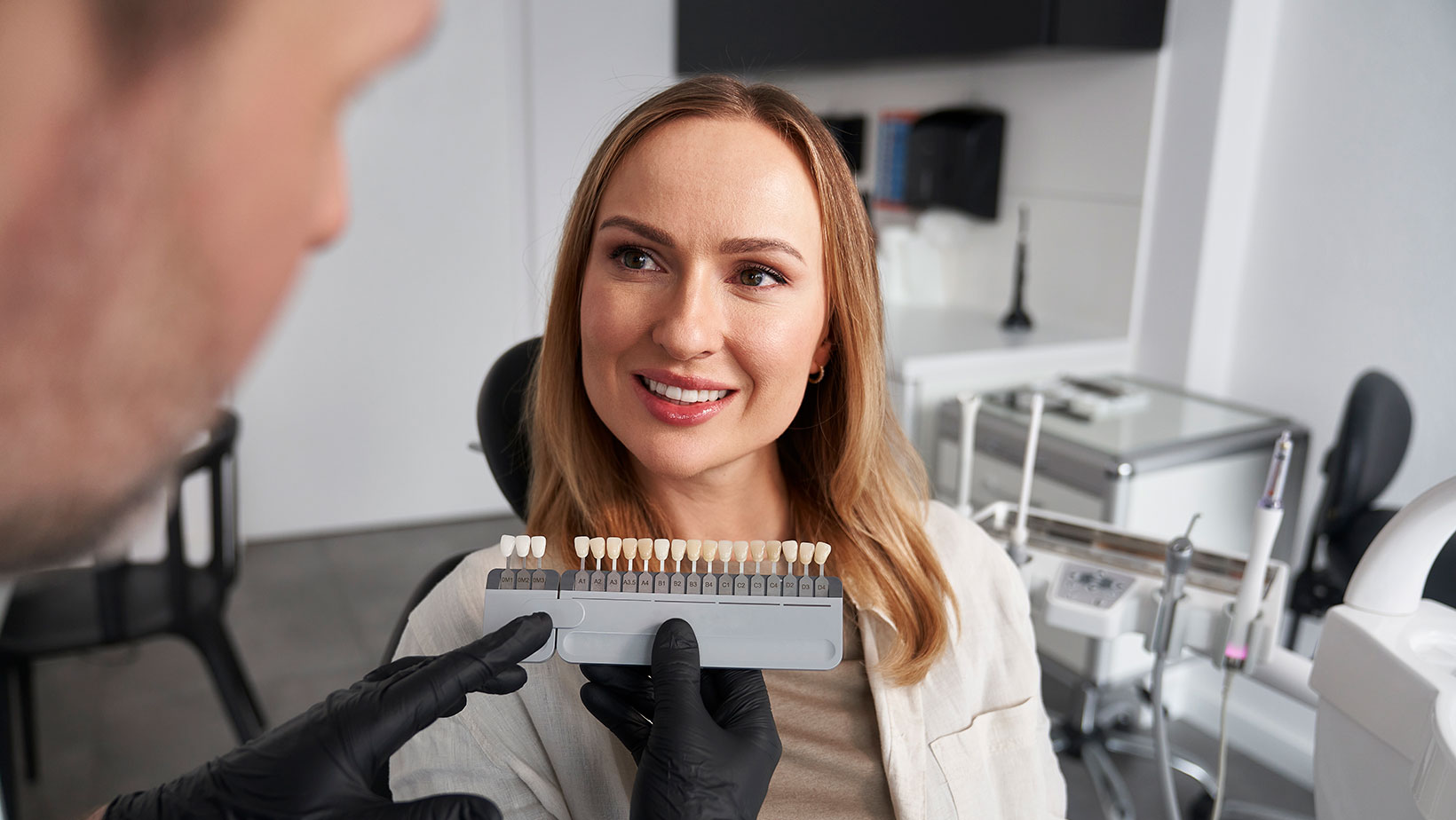Dental procedures are by far the most common type of cosmetic procedures. According to a 2023 Statista survey, out of all cosmetic procedures done, 46% of them were some form of cosmetic dental work. This is a much larger percentage than those who get things like weight loss surgery or breast augmentation. Part of the reason could be that many dental procedures deemed “cosmetic” are also sometimes necessary for the patient’s health.
Those in need of cosmetic dentistry for either medical or aesthetic reasons are left wondering whether their dental insurance will cover these types of procedures. The answer depends on the reason for the dental work and the patient’s insurance coverage.
How Does Dental Insurance Work?
Dental insurance is separate from a health insurance plan and is usually sold as an optional add-on. The majority of policies cover 100% of regular office visits for cleanings and check-ups twice a year. This may include x-rays done during these visits. What is covered beyond these preventative visits will vary from plan to plan, but many follow a similar structure.
Most dental plans cover 80% of fillings or other basic procedures and 50% of major medically necessary restorative procedures, like crowns or dentures. The patient pays for the remaining portion and these percentages might vary. Some of these plans include an annual maximum that will only cover up to a certain amount per year, or a deductible that must be met before procedures are covered.
Cosmetic dentistry is typically not covered unless it is also medically necessary. There may also be limits or restrictions on fillings and crowns. For example, resin or silver amalgam fillings or crowns might be covered, while porcelain and gold are not.
What Counts as Cosmetic Dentistry?
Cosmetic dental procedures are typically those meant to make the patient’s teeth look better. Non-cosmetic dentistry is meant to prevent disease, or correct injury or decay. Some dental procedures are obviously only cosmetic in nature, while others straddle the line between cosmetic and medically necessary. Insurance will often only pay when there is a medical reason for the dental work. So, which procedures are typically considered cosmetic by insurance company standards?
Teeth Whitening
Teeth whitening or bleaching is a purely aesthetic procedure and is not typically covered by insurance. There are no situations in which making teeth a lighter color can be considered a solution for a decayed, diseased, or injured tooth. However, teeth cleaning is a different story and may be covered. Regular teeth cleanings can remove some stains and prevent periodontal disease and tooth decay.
Veneers
Veneers are usually cosmetic in nature. They consist of a thin layer of material applied over a tooth to conceal cosmetic imperfections on the surface of teeth. This includes stubborn staining that regular teeth whitening can’t remove, chips or cracks, and imperfections in the size and shape of a tooth. Veneers would only be covered by insurance if they can serve a medical purpose.
Dental Implants
Dental implants are permanent replacements for extracted teeth and are attached to the jaw by a titanium screw. Dental implants fall into the confusing gray area between cosmetic and medically necessary dentistry because, while no one wants a tooth missing from their smile, the open space in the jaw can also cause issues with bone loss. A dental implant can preserve the jaw bone and prevent further tooth loss in the future.
Dental Crowns
Dental crowns are often used to fix imperfections in teeth in a similar way as veneers. If that is their only purpose, they are considered cosmetic. However, most crowns are also employed in many restorative procedures and to preserve cracked or broken teeth. They are also important as part of a root canal procedure.
Dental Bonding
Dental bonding is most often used for cosmetic purposes, like reshaping the teeth, fixing discoloration, or filling in gaps.
Gum Contouring
While gum contouring can be medically necessary, it is usually done for cosmetic reasons. In particular, gum contouring is used to make a smile less “gummy”. This involves reshaping the gums so that less gum (and more teeth) show when a person smiles.
Orthodontics for Aesthetic Purposes
While not technically dentistry, orthodontic procedures, like braces and Invisalign, are usually used for aesthetic purposes. Straightening out teeth and fixing gaps or overcrowding is generally considered cosmetic in nature. There are cases, however, when having the teeth straightened is recommended for the patient’s health.

When is Cosmetic Dentistry Medically Necessary?
As a general rule of thumb, cosmetic dentistry becomes a medically necessary procedure if disease progression, pain, infection, or decay will occur without it. Below are the most common cases of this.
- Veneers or crowns can be used to protect teeth with eroded enamel. Without protection, the tooth is likely to experience cavities and decay.
- Crowns for covering teeth after a root canal.
- Braces or invisalign to correct a bite that is causing pain and other TMJ related issues.
- Crowns or bonding procedures to prevent cracked teeth from becoming infected, decaying, or breaking in half.
- Gum contouring for treating periodontal disease or gingival hyperplasia.
- Dental implants that are necessary for preventing deterioration of the jaw.
It is important to note that even when these procedures are covered, they are almost never covered at 100%. Generally, dental insurance will cover 50% to 80%. There might also be a waiting period if the patient has received coverage recently. It is always best to check with the insurer before the procedure.
Do Any Dental Insurance Plans Pay for Purely Cosmetic Dental Procedures?
Yes! Although these policies are not the norm, there are some dental insurance plans that cover a portion of cosmetic dentistry procedures that are not medically necessary. For example, Cigna offers some dental plans that help to cover the costs of orthodontic procedures by up to $1000 and Guardian offers plans that cover 50% of dental implants up to $1000. Be aware that the monthly premium for these plans tends to be higher than average.
Another option is a dental discount program. These programs offer discounts on various procedures, like dental exams, teeth whitening, and root canals with a yearly subscription.
Finding the Right Dentist for Cosmetic Dentistry
Most dentists perform cosmetic dentistry in addition to checkups and tooth fillings. Some offer financing options for all dental work, including cosmetic dentistry procedures. There are also specialists who focus on orthodontics, restorative procedures, or practices focusing on family cosmetic dentistry. Ask what types of discounts or payment plans are available for your procedure.
You can find a dentist to fit any specific needs with our dentist locator tool. Find a provider in your area and make an appointment today.





